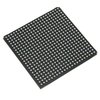Part Details for XC6SLX75-2CSG484I by AMD Xilinx
Results Overview of XC6SLX75-2CSG484I by AMD Xilinx
- Distributor Offerings: (4 listings)
- Number of FFF Equivalents: (0 replacements)
- CAD Models: (Request Part)
- Number of Functional Equivalents: (0 options)
- Part Data Attributes: (Available)
- Reference Designs: (Not Available)
Tip: Data for a part may vary between manufacturers. You can filter for manufacturers on the top of the page next to the part image and part number.
XC6SLX75-2CSG484I Information
XC6SLX75-2CSG484I by AMD Xilinx is a Field Programmable Gate Array.
Field Programmable Gate Arrays are under the broader part category of Programmable Logic Devices.
Programmable Logic Devices (PLDs) are reconfigurable digital components that can be customized for different applications, offering flexibility and improved performance over fixed logic devices. Read more about Programmable Logic Devices on our Programmable Logic part category page.
Price & Stock for XC6SLX75-2CSG484I
| Part # | Distributor | Description | Stock | Price | Buy | |
|---|---|---|---|---|---|---|
|
|
Bristol Electronics | 1 |
|
RFQ | ||
|
|
MacroQuest Electronics | ISO 9001: 2015, ISO 14001:2015, ISO 45001:2018 | 988 |
|
$64.0000 / $137.1400 | Buy Now |
|
|
Vyrian | Programmable ICs | 4 |
|
RFQ | |
|
|
Win Source Electronics | IC FPGA 328 I/O 484CSBGA | 3050 |
|
$37.5375 / $48.4860 | Buy Now |
Part Details for XC6SLX75-2CSG484I
XC6SLX75-2CSG484I CAD Models
XC6SLX75-2CSG484I Part Data Attributes
|
|
XC6SLX75-2CSG484I
AMD Xilinx
Buy Now
Datasheet
|
Compare Parts:
XC6SLX75-2CSG484I
AMD Xilinx
Field Programmable Gate Array, 5831 CLBs, 667MHz, 74637-Cell, CMOS, PBGA484, 19 X 19 MM, 0.80 MM PITCH, LEAD FREE, BGA-484
|
| Pbfree Code | Yes | |
| Rohs Code | Yes | |
| Part Life Cycle Code | Transferred | |
| Ihs Manufacturer | XILINX INC | |
| Part Package Code | BGA | |
| Package Description | 19 X 19 MM, 0.80 MM PITCH, LEAD FREE, BGA-484 | |
| Pin Count | 484 | |
| Reach Compliance Code | compliant | |
| ECCN Code | 3A991.D | |
| HTS Code | 8542.39.00.01 | |
| Clock Frequency-Max | 667 MHz | |
| Combinatorial Delay of a CLB-Max | 0.26 ns | |
| JESD-30 Code | S-PBGA-B484 | |
| JESD-609 Code | e1 | |
| Length | 19 mm | |
| Moisture Sensitivity Level | 3 | |
| Number of CLBs | 5831 | |
| Number of Inputs | 310 | |
| Number of Logic Cells | 74637 | |
| Number of Outputs | 310 | |
| Number of Terminals | 484 | |
| Operating Temperature-Max | 100 °C | |
| Operating Temperature-Min | -40 °C | |
| Organization | 5831 CLBS | |
| Package Body Material | PLASTIC/EPOXY | |
| Package Code | FBGA | |
| Package Equivalence Code | BGA484,22X22,32 | |
| Package Shape | SQUARE | |
| Package Style | GRID ARRAY, FINE PITCH | |
| Peak Reflow Temperature (Cel) | 260 | |
| Programmable Logic Type | FIELD PROGRAMMABLE GATE ARRAY | |
| Qualification Status | Not Qualified | |
| Seated Height-Max | 1.8 mm | |
| Supply Voltage-Max | 1.26 V | |
| Supply Voltage-Min | 1.14 V | |
| Supply Voltage-Nom | 1.2 V | |
| Surface Mount | YES | |
| Technology | CMOS | |
| Temperature Grade | INDUSTRIAL | |
| Terminal Finish | Tin/Silver/Copper (Sn96.5Ag3.0Cu0.5) | |
| Terminal Form | BALL | |
| Terminal Pitch | 0.8 mm | |
| Terminal Position | BOTTOM | |
| Time@Peak Reflow Temperature-Max (s) | 30 | |
| Width | 19 mm |
XC6SLX75-2CSG484I Frequently Asked Questions (FAQ)
-
The maximum power consumption of XC6SLX75-2CSG484I is approximately 1.5W, but it can vary depending on the design and operating conditions.
-
To implement a DDR3 memory interface with XC6SLX75-2CSG484I, you need to use the Memory Interface Generator (MIG) tool provided by Xilinx, which generates the necessary IP cores and interface logic.
-
The maximum clock frequency supported by XC6SLX75-2CSG484I is 450 MHz, but it can be limited by the design and operating conditions.
-
To optimize power consumption, use the Xilinx Power Estimator (XPE) tool to estimate power consumption, and then apply power-saving techniques such as clock gating, voltage scaling, and dynamic voltage and frequency scaling.
-
Yes, XC6SLX75-2CSG484I is suitable for high-reliability applications, as it is fabricated using a 45nm process and has built-in features such as error correction and single-event upset (SEU) mitigation.
